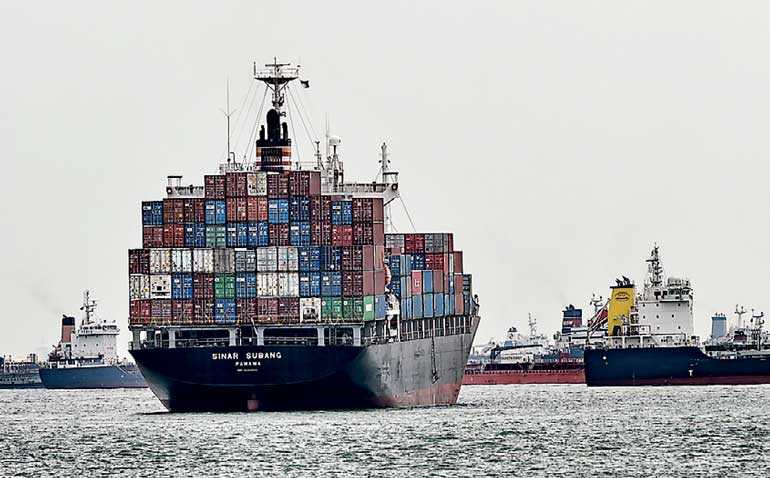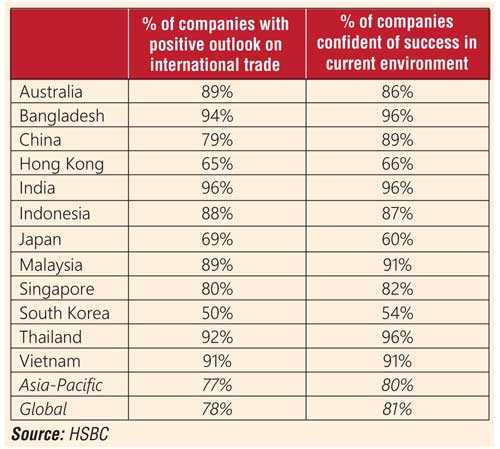Saturday Apr 20, 2024
Saturday Apr 20, 2024
Thursday, 1 November 2018 00:48 - - {{hitsCtrl.values.hits}}

Fuelled by the region’s economic prospects and consumer confidence, Asian businesses are feeling positive about the trading environment, a new HSBC global report finds.
However, the survey also reveals that Asian companies’ upbeat outlook is not uniform across the region with pockets of pessimism, and to counteract heightened protectionism many Asian businesses are turning their attention to trade opportunities nearer to home.
According to the study, 77% of companies in Asia have a positive outlook on trade – broadly consistent with their global peers (78%). On balance, 80% of Asian businesses are confident that they will succeed in the current trading environment, though this feeling doesn’t translate to every market in the region.
These insights are part of HSBC’s Navigator: Now, next and how for business report - a global survey of more than 8,500 corporates across 34 markets around the world that gauges sentiment and expectations on trade activity and business growth. More than 3,300 companies in 12 markets in the Asia Pacific region took part in the Navigator survey. 
HSBC Sri Lanka and Maldives Head of Wholesale Banking Stuart Rogers said: “Trade corridors play an important role for Sri Lankan corporates looking to expand their businesses beyond Sri Lanka and push for exponential growth. Knowledge of these markets is essential for businesses to thrive. The Navigator offers our corporate customers up-to-date information and invaluable insights into critical offshore markets.”
Stars shine bright in South and Southeast
The latest Navigator findings show that India, Bangladesh, Thailand and Vietnam score the highest in the world, with more than nine in 10 companies having a positive outlook on trade. Businesses in Malaysia join their neighbouring markets at the top of the league tables with, again, more than nine in 10 firms citing strong potential to succeed in the current trading environment.
HSBC Asia Pacific Regional Head of Commercial Banking Stuart Tait said: “Asian businesses are at a crossroads – buoyed by macroeconomics but concerned about geopolitics. Businesses are staying positive, but they’re also signalling that protectionism is a significant concern.”
Optimism wanes in
East due to
protectionist pressure
While businesses in South and Southeast Asia are brushing away fears of protectionism, things in East Asia are not as rosy. As they depend heavily on both China and the US and face tough choices as the trade dispute drags on, companies in South Korea, Japan and Hong Kong are less positive and less confident.
Tait continued: “Though the near-term sentiment of certain markets has been adversely affected by market volatility and geopolitical pressures, Asia’s rising middle class and their increasing level of consumption are long-term structural trends that will power economic growth in the region for years to come. They key is for businesses in this region to adapt their approach and market-reach to stay fit for growth.”
(Trade) War / What
is it good for?
HSBC’s Navigator survey was conducted between late July and mid-September, when the first tranche of tariffs ($34 billion) in the US-China trade dispute had been implemented; the second tranche ($16 billion) took effect; and the third tranche ($200 billion) was announced.
Trade tensions were clearly reflected in business sentiment across the region. Although Asian firms believe in the region’s economic growth and consumer confidence, they are concerned that geopolitics may spill over and lead to an economic downturn.
Among the top geopolitical factors cited by Asian companies with a negative outlook are increased protectionism and tariffs. Partly as a result, Asian firms have identified Asia as their top growth market as they look to expand via intra-regional trade.
HSBC Asia Pacific Regional Head of Global Trade and Receivables Finance Ajay Sharma said: “It’s important to remember that protectionism is not a new phenomenon - trade always finds its equilibrium.”
Sharma believes that much like trade always finding equilibrium, businesses always innovate, adapt and respond to their environment. “Against the backdrop of protectionism, we’re seeing Asian businesses re-examine their trade strategies. Our findings show an increased emphasis on the use of technology amongst Asian corporates as well as a strategy to expand into new markets to better control their supply chains and lower the risk of business interruption,” he said. Sharma concluded: “Despite the trade rhetoric, the free trade banner continues to fly high in Asia and the region’s macroeconomics remain strong.”
Further integration in the Association of Southeast Asian Nations, the Regional Comprehensive Economic Partnership and the Belt and Road Initiative are expected to deliver trade growth in Asia, and Japan and Singapore recently signed free trade deals with the European Union.